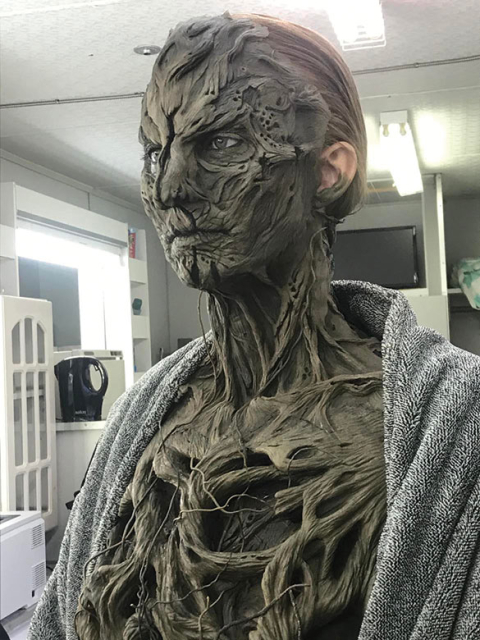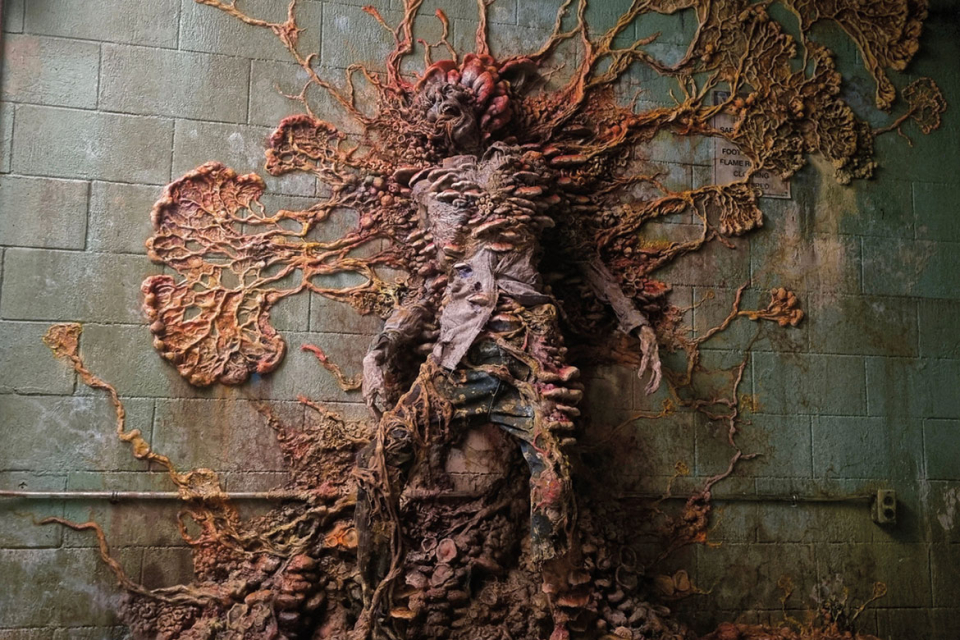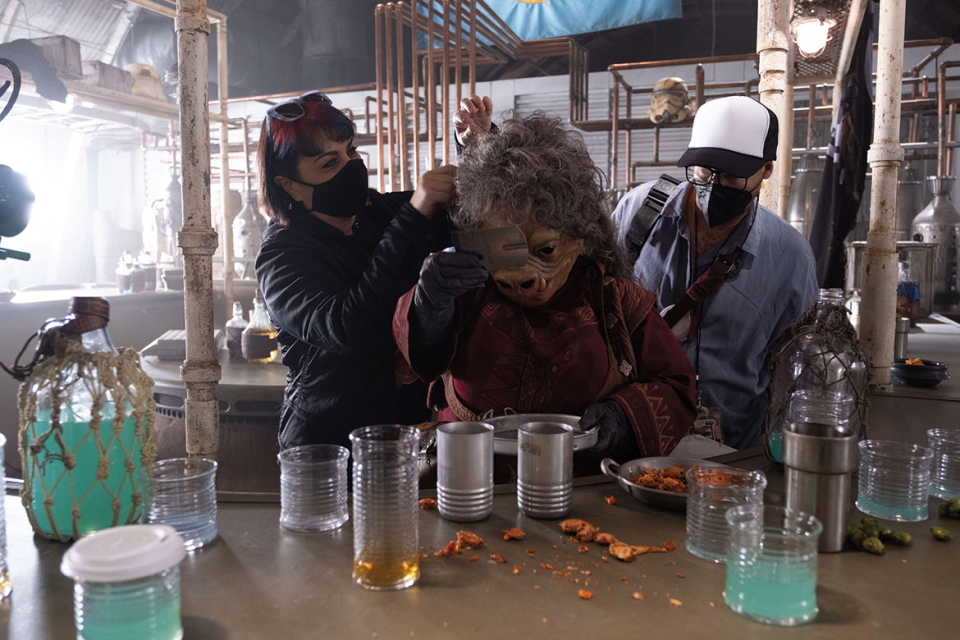While CGI can enhance special-effects makeup designs, much of what appears onscreen is still achieved with paint and practical prosthetics. Meet the artists behind some of this past season's most memorable designs.
EVIL
Paramount+
"The Demon of the End," Season 3, Episode 10
JOEL HARLOW, SPECIAL CHARACTER DESIGNER
Old demons rarely die — unless Sister Andrea (Andrea Martin) smashes them with a shovel — but several of the demons Harlow and his team created gather together at the end of Evil's third season.
"It's the culmination of every character, except for one, that we made for the first three seasons," Harlow says. "Every character we've made, all the makeups we've designed, the animatronic puppets we've created.
"We've got the Teke-Teke coming out of the cabinet and getting smashed. We've got several puppets getting smashed by Sister Andrea. Then they're all converging around the baby in a sort of manger sequence at the end, which is bizarre and frightening, but a little humorous."
One actor, Marti Matulis, plays most of the demons, so a lot of time was spent getting him in and out of makeup — which, as Harlow explains, proved to be the lesser of two evils.
"Contact lenses are custom made, teeth are custom made. Really, all of these pieces are custom made — the creature suits, the makeups that tie into those suits — so we would have had to remake everything on another performer, times ten, for that sequence."
Harlow's demons can be comical or downright terrifying, but he doesn't view them as monsters. "They're just who they are," he says. "They all have unique personalities. They're not just monsters for the sake of being monsters."
His concept for the demon-human hybrid baby sprang from an unusual inspiration. "What's always creeped me out is watching Man vs. Wild," Harlow declares, "where you've got Bear Grylls out in the woods. He cracks open a log to find fat, gross, white little grubs and starts popping them in his mouth. I wanted the baby to look like that, but also be very asymmetrical, like it doesn't really know what it should be. It's not formed yet. It's still growing."
While the details often borrow from nature, Harlow — an Oscar winner for Star Trek and an Emmy winner for The Shining and The Stand — credits the twisted imaginations of everyone in his studio, Morphology FX in Van Nuys, California, for bringing everything to life. "It's really mind-blowing — and when I say this, it's in appreciation of my team — how much quality work is in that episode."
GUILLERMO DEL TORO'S CABINET OF CURIOSITIES
Netflix
"Dreams in the Witch House," Season 1, Episode 6
SEAN SANSOM, HEAD, SPECIAL MAKEUP EFFECTS DEPARTMENT MIKE HILL, CREATURE DESIGNER AND CO-HEAD SPECIAL MAKEUP EFFECTS DEPARTMENT
Regal, elegant and terrifying. That's how Sansom and Hill conceived the witch Keziah (played by Lize Johnston), who is pivotal to this episode of Guillermo del Toro's horror anthology series.
Starting with concept art from del Toro and creature concept designer Guy Davis, Hill proposed that Keziah, who resides in a wood, represent the dark, dense, marshy parts of the forest.
"We knew a silhouette would have an impact on the audience and help tell her story," Hill explains. "She's not to be trifled with. She looks extremely nasty, but you have to keep an intelligence about her, as well as the grotesqueness and regality, since she's the queen of the forest. When all of that's taken in, it's not simply a monster — it's a main character. If she didn't work, the episode wouldn't work."
Sansom and Hill worked on several episodes of the series, but this one was special.
"In other episodes, the creatures don't drive the story," says Sansom, an Emmy winner for HBO's Grey Gardens. "With Keziah, she's the reason the main character [Walter, played by Rupert Grint] is doing what he's doing. A lot of the other creatures we've done for the show are only in key scenes, but she was in a lot of script pages. I think she was on the schedule twelve days out of the twenty-four-day shoot."
They call Keziah's intricate headpiece — essentially a crown of twigs that allows special-effects embers to flow in her wake — an engineering marvel.
"It was a large structure, and it was difficult to get the balance right," Hill says. "At some point you think, 'Is this particular element going to be worth it?' But it certainly was, because it gave her a grace and majestic silhouette in that dark forest."
Completing the look took four facial appliances, sharp teeth, a "woodland ribs" chest-piece that accommodated more embers and branch-like gauntlets.
For this episode, Hill also turned actor DJ Qualls into Keziah's rat-man familiar, Jenkins — using several appliances, complex dentures and a cowl to cover the head and neck with fur — while Sansom built Jenkins's little rat skeleton, complete with a tiny human-like skull.
THE LAST OF US
HBO
"Infected," Season 1, Episode 2
BARRIE GOWER, PROSTHETICS DESIGNER
In HBO's post-apocalyptic series — based on a popular videogame in which parasitic cordyceps fungi turn humans into zombies (as cordyceps actually do with insects) — it isn't till the second episode that viewers see what long-term infection looks like.
"The most extremely infected characters are called the Clickers," Gower explains. "The parasite basically makes a channel for the brain and large funguses start sprouting from the skin and from the skull — it splits the cranium, creating a huge crevice down the center of the face, and splits the palate as well.
"It's a beautiful design that they created for the game, so the biggest challenge for us was establishing these infected stages." His team spent several months refining the stages of infection, leading up to the technically challenging Clickers.
"In profile, the crevice is so deep that you have negative space," he says. "As prosthetic artists, we can add to a performer's face, but we can't take away or make anything shallower than their actual skin." Originally, the team thought visual effects would be needed to achieve the desired depth, but the initial makeup test — without visual effects — was successful.
The episode includes a museum sequence that took more than a week to shoot, requiring extensive makeup and sixty performers who needed new sets of appliances every day. It also features a Clicker dubbed "The Kisser."
"He's the character who stops in his tracks, then walks toward the character Tess [Anna Torv]," Gower says. "He kisses her and tendrils come out of his mouth."
Gower — who also worked on HBO's Game of Thrones (where he won three of his four Emmys) — says the sheer scope of work required for The Last of Us presented one of the biggest technical challenges his London-based company, BGFX (founded with his wife, Sarah), has faced.
"We had a team of about sixty who worked on The Last of Us in our workshop, and we made the majority of our prosthetics there. We had another team in Calgary — who were on the whole production for over twelve months — headed by our prosthetic supervisor, Paul Spateri, and a team of three other artists," says Gower, who made the transatlantic trip for key episodes like "Infected."
THE MANDALORIAN
Disney+
"Chapter 22: Guns for Hire," Season 3, Episode 6
CRISTINA WALTZ, MAKEUP DESIGNER
As a Star Wars fan, Waltz strives to honor past creature designs while creating new characters that complement the universe, like the Quarren captain, Shoggoth, first seen submerged in water.
"We used a stunt actress because we needed someone who'd be comfortable in a tank of water with a full makeup glued to her face," Waltz says. "Putting a makeup underwater is always tricky — you want to make sure everything stays put."
While the semi-aquatic Quarren already existed in the Star Wars universe, most are male. "There's a little more femininity to this character," Waltz notes. "Seeing the difference between the male and female was really fun."
Making the Quarren's tentacles suitably ethereal required additional effects, so Waltz made them easily removable.
"They're magnetic, so we can remove them should visual effects need to do something specific with them. The collaboration between departments was pretty important with the tentacles. It can be hard to give all of that movement elegance with animatronics, so we shot the scenes with and without the tentacles. That way they could enhance what they needed."
Though the same sequence includes the Quarren captain's love interest — who belongs to another semi-aquatic species, Mon Calamari — neither character appears later in the episode.
"When we build these characters, we hope we can use their makeups elsewhere," Waltz says. Her team created a mask of the female Quarren that can be used later for background characters.
"Even though she's only seen at the beginning of the episode, it was very fulfilling making this character come to life. Whether they're on the screen for a minute or the whole show, it's really satisfying."
The episode also has a dining-room scene with a colorful assortment of aliens.
"At the table, we had a Sullustan character — the jaw moved and it was built more like a mask," Waltz says. "We also had a Snivvian, which is also known as Snaggletooth. Again, that was a very specific build, so the jaw could move and have a uniqueness — but at the same time, it was more of a tight-fitting mask.
"Part of my job is thinking months ahead. We'd been working on the Quarren build, for example, probably three or four months before we actually shot. We were quite busy for the whole season — even though Number One [Pedro Pascal, the series' lead] was in a helmet."
This article originally appeared in emmy magazine issue #7, 2023, under the same title.




















